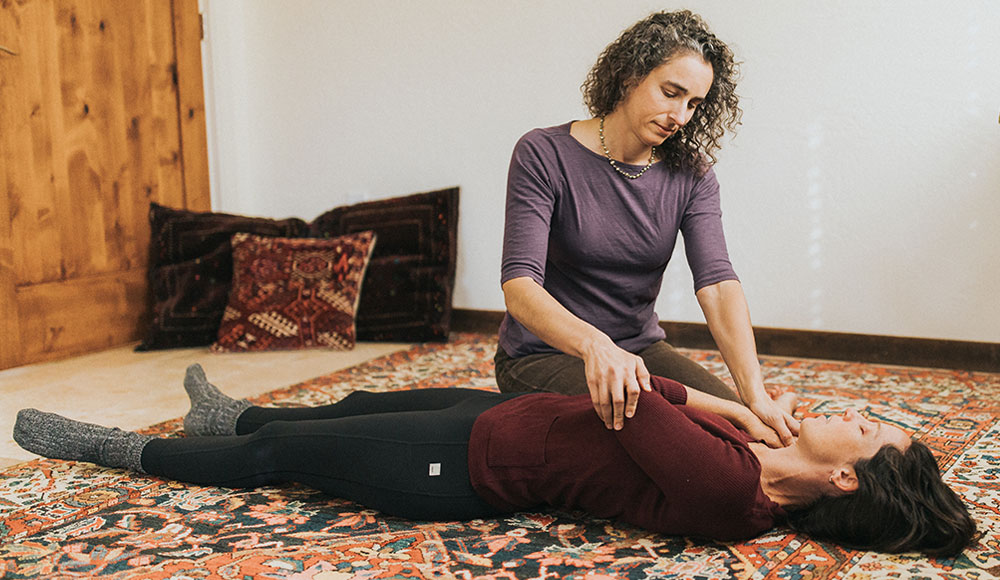In a town known for its abundance of alternative health offerings—from somatic therapy to sound baths to sacred cacao ceremonies—it takes something truly unique to stand out. Until recently, I hadn’t heard of Breema, a gentle bodywork and self-care practice centered around presence, touch and harmony. But as someone always curious about new ways to reconnect with mind and body, I was intrigued when a fellow wellness maven invited me to join her for a group session last spring.
Our drive took us through the single-lane roads just outside of Santa Cruz to a quiet compound under a canopy of trees. The setting was serene. An iron get led us up a long gravel driveway, passing vibrant rows of grape vines along the way. Passing several more buildings, we came to what appeared to be a converted barn. Inside, the large open space was flanked with dark grainy wood covered in oriental carpets. Despite the lofty ceilings, the space was warm and inviting: plush rugs, natural wood beams, soft lighting. But the real invitation wasn’t just in the ambiance—it was the quiet, the invitation to slow down.
At first, the practice itself felt foreign to a newbie. The instructions were minimal, more like a demonstration of slow, synchronized movements performed with partners. Some of the attendees were couples; others, like me and my friend, paired up with people we didn’t know but opted to work with.
Together we practiced giving and receiving through grounded, nonjudgmental touch. While Breema wasn’t exactly love at first self-hug for me, I left with the sense that something deeper was happening—something worth revisiting.
Months later, I got my second chance. Dr. Alexandra Johnson, a local integrative physician and long-time Breema practitioner, invited me to experience a private session like those she incorporates into her medical practice. I immediately said yes.
I walked into an atypical doctor’s office that mirrored the peaceful aesthetic of the group space, with another well-loved rug anchoring the floor and soft natural light filling the room. Dr. Johnson welcomed me with an ease that made it easy to settle in. I lay fully clothed on a padded surface as she gently moved my limbs and head, applied light stretches and used rocking motions to help my body unwind. The movements were subtle, yet deeply calming. Something shifted.
“It’s not massage,” Dr. Johnson clarified when I asked her to explain what she had done. “It’s not reiki or structural alignment. Breema is energy work, guided by the body’s innate wisdom.” Her words were grounded, precise—and often punctuated with a warm laugh that made me feel instantly at ease.
Dr. Johnson first discovered Breema at 19 while training as a doula. “I wanted something that could support women during pregnancy and birth,” she shared. “But I also noticed that when I gave Breema, I felt better too. It’s not just for the recipient. It supports the giver as well.”
That mutual benefit is one of the practice’s foundational elements. Breema isn’t a technique to be mastered; it’s a presence practice, built on what Dr. Johnson calls “the Nine Principles of Harmony”—concepts like No Judgment, Body Comfortable, and Mutual Support. “It’s how the body moves when we’re present,” she says. “Breema helps align the body, mind and feelings so we can stay connected to ourselves.”
In her integrative medical practice, Dr. Johnson uses Breema as both a diagnostic and therapeutic tool. “When a patient comes in, I absolutely want to help relieve their pain,” she says. “But I also hold a Breema perspective, which says: however this person is showing up today—that’s their starting point. They don’t need to be fixed. They just need support to take the next step.”
Her approach feels especially relevant in a post-pandemic world where anxiety, burnout and chronic stress are more common than ever. “Many of my patients are health care professionals themselves,” she reveals. “They’re tired. They’re overwhelmed. Breema helps them reconnect with a sense of vitality.”
Dr. Johnson speaks from experience. Years ago, while living in Africa, she developed chronic fatigue syndrome. “It was debilitating,” she recalls. “But Breema helped me come back to balance—not just physically, but emotionally and spiritually.” That lived experience now shapes how she helps others navigate their own healing journeys.
Breema sessions can be one-on-one or practiced in a group. During a session, you remain fully clothed and rest on a soft surface while the practitioner uses rhythmic movements tailored to your body. The practice also includes Self-Breema, a form of guided movement you can do on your own, and a range of accessible classes—many of them online.
So what would she say to someone who’s curious but unsure? “Start with a class,” Dr. Johnson encourages. “Try a free session online at Breema.com. Just one class can help you experience what it feels like to be more present in your body, without judgment.”
In a world full of wellness trends and quick fixes, Breema invites us into something simpler. Something slower. Something that begins with the belief that we are not broken—we’re just out of sync. And there’s always a way back.













This is the real deal!
As a wounded healer I have explored a great many body-mind therapies, on my own healing path and to help others.
Breema invites us to experience existence in the moment through movement sequences that are profound in their playful simplicity, stimulating the life force and nurturing us deeply.
The Nine Principles of Breema offer a way in to clarity and balance whatever we are doing.
I heartily recommend Breema for anyone who would like to feel more complete and connected to what is.